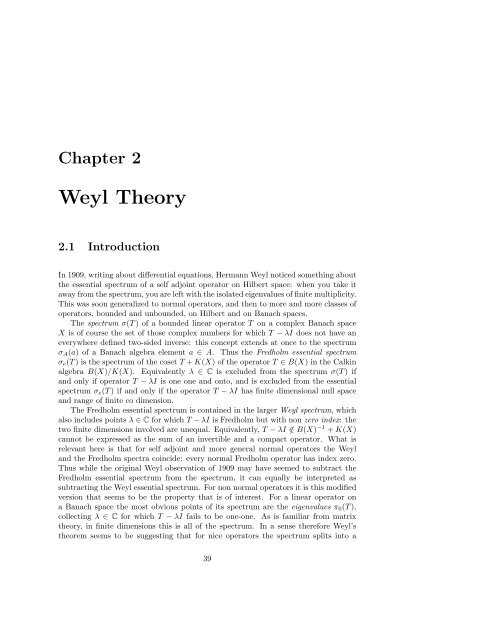Woo Young Lee Lecture Notes on Operator Theory
Woo Young Lee Lecture Notes on Operator Theory
Woo Young Lee Lecture Notes on Operator Theory
You also want an ePaper? Increase the reach of your titles
YUMPU automatically turns print PDFs into web optimized ePapers that Google loves.
Chapter 2<br />
Weyl <strong>Theory</strong><br />
2.1 Introducti<strong>on</strong><br />
In 1909, writing about differential equati<strong>on</strong>s, Hermann Weyl noticed something about<br />
the essential spectrum of a self adjoint operator <strong>on</strong> Hilbert space: when you take it<br />
away from the spectrum, you are left with the isolated eigenvalues of finite multiplicity.<br />
This was so<strong>on</strong> generalized to normal operators, and then to more and more classes of<br />
operators, bounded and unbounded, <strong>on</strong> Hilbert and <strong>on</strong> Banach spaces.<br />
The spectrum σ(T ) of a bounded linear operator T <strong>on</strong> a complex Banach space<br />
X is of course the set of those complex numbers for which T − λI does not have an<br />
everywhere defined two-sided inverse: this c<strong>on</strong>cept extends at <strong>on</strong>ce to the spectrum<br />
σ A (a) of a Banach algebra element a ∈ A. Thus the Fredholm essential spectrum<br />
σ e (T ) is the spectrum of the coset T + K(X) of the operator T ∈ B(X) in the Calkin<br />
algebra B(X)/K(X). Equivalently λ ∈ C is excluded from the spectrum σ(T ) if<br />
and <strong>on</strong>ly if operator T − λI is <strong>on</strong>e <strong>on</strong>e and <strong>on</strong>to, and is excluded from the essential<br />
spectrum σ e (T ) if and <strong>on</strong>ly if the operator T − λI has finite dimensi<strong>on</strong>al null space<br />
and range of finite co dimensi<strong>on</strong>.<br />
The Fredholm essential spectrum is c<strong>on</strong>tained in the larger Weyl spectrum, which<br />
also includes points λ ∈ C for which T − λI is Fredholm but with n<strong>on</strong> zero index: the<br />
two finite dimensi<strong>on</strong>s involved are unequal. Equivalently, T − λI /∈ B(X) −1 + K(X)<br />
cannot be expressed as the sum of an invertible and a compact operator. What is<br />
relevant here is that for self adjoint and more general normal operators the Weyl<br />
and the Fredholm spectra coincide: every normal Fredholm operator has index zero.<br />
Thus while the original Weyl observati<strong>on</strong> of 1909 may have seemed to subtract the<br />
Fredholm essential spectrum from the spectrum, it can equally be interpreted as<br />
subtracting the Weyl essential spectrum. For n<strong>on</strong> normal operators it is this modified<br />
versi<strong>on</strong> that seems to be the property that is of interest. For a linear operator <strong>on</strong><br />
a Banach space the most obvious points of its spectrum are the eigenvalues π 0 (T ),<br />
collecting λ ∈ C for which T − λI fails to be <strong>on</strong>e-<strong>on</strong>e. As is familiar from matrix<br />
theory, in finite dimensi<strong>on</strong>s this is all of the spectrum. In a sense therefore Weyl’s<br />
theorem seems to be suggesting that for nice operators the spectrum splits into a<br />
39













